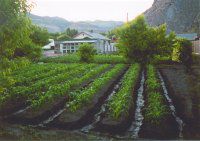| The space in the Callor’s yard is deceiving. One garden leads to another and then another. |
The saying goes that a man is measured by his works on this earth. For most that probably means a persons spiritual works, but what about if the spirit is mixed with the material?
Bill Callor, a Helper resident, considers himself a common man; one with only a little story to tell. But his friends know differently.
Just ask Al Rojas, another Helperite. One day he and Callor were walking through the latters extensive gardens and Callor looked up into the sky and then down at the ground.
“Al, do you think my parents are proud of me?”
An interesting question from a man in his 70’s, whose father and mother passed away many years ago.
It all began when Callor’s father came to the United States in 1890 and his mother emigrated in 1903. In the early years the family resided in Kenilworth, as the senior Callor worked in the mines there. During that time they lived in two houses; one burned down and they had to move to another. With 11 kids to feed it was a tough time, just as it was for many depression era families. Kenilworth afforded little chance for a garden of any kind; the soil wasn’t great and there wasn’t much water.
Then in 1945, with a number of children still at home, the family moved to Helper and the gardening began in earnest.
“This house was a god send,” says Callor. “Kenilworth was a great place to live, but this house and it’s area for a garden was heaven.”
And garden they did. The senior Callor took real pride in his garden and loved rock work too. He even began building another house at the back of the property made entirely of rock. It still stands as a monument to his work today.
“My father was a perfectionist,” says Callor. “I used to come home from work and begin working in the garden. He always made sure it was done right. He’d tell me if it wasn’t.”
Right meant straight rows, proper planting and meticulous weeding. It also meant a plentiful harvest in the late summer and fall.
The garden included just about every vegetable and fruit that could be grown in this desert region.
But for Callor it wasn’t always easy for him to keep the garden the way he wanted it and up to his dad’s expectations. Like everyone who tries to maintain a hobby or passion, life gets in the way sometimes.
While working as a section laborer for the Rio Grande Railroad in 1948, he was drafted and spent three years in Japan on a tour of duty.
That is also where he met his first wife of 29 years. They had two sons and lived a great life in Helper after he returned from the military. He worked for a few more years and then went on to become a road master on the Utah Railway for 15 years before he retired.
But during his time on the Utah Railway his wife returned to Japan for a visit to relatives. But before she could return, he was summoned to the island country. She was so sick she could not come back and not long after he arrived she passed away.
| Bill Callor stands in his greenhouse where he starts plants early in the spring. |
All this time his heritage, the home and the garden his father had passed on to him was well taken care of, but not the way he wanted it to be. After remarrying in the late 1980’s and retiring from the railroad in 1991, his passion, making that historical garden perfect, took over almost full time.
He built a greenhouse on the back of a garage on the property. There he began to start and keep plants.
Today, Callor and his wife Gloria, spend the time making sure every inch of the property that isn’t paved is yielding something good to eat or beautiful to look at.
A kitchen downstairs is used only for canning and putting up the goodies they grow. What is he the proudest of? It’s hard to tell, although one could get the impression his grapevines, anchored on one end by an old manual railroad signal are close to his favorite.
“Here, taste some of these grapes,” he said as he took some of the deep purple fruit from the vines.
Another favorite is cantaloupe or his version of them.
“These are kind of a cross between a honey dew and a cantaloupe,” he says as he cuts a piece of the pale orange fruit and puts it on the table. “They just kind of ended up this way. I threw some seed out and they grew.”
Probably the largest yield, however, comes from the tomato plants that grow in exact straight rows.
“We make a lot of tomato paste,” says Gloria.
“Both my wives have made a lot of tomato paste,” says Callor.
All this begs the question: Are his parents proud of his garden and what he has done with it?
It’s hard to imagine they wouldn’t be.

